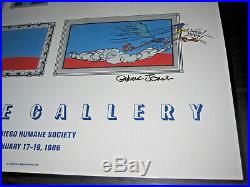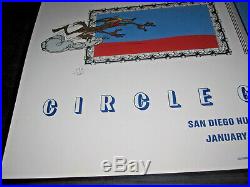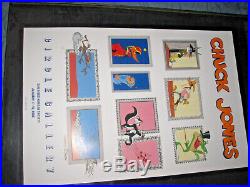VTg 1986 Chuck Jones signed gallery event poster Warner Bros cartoon art 24x36








This is a genuine original January 17-19 , 1986 Warner Brothers characters hand signed in marker by Chuck Jones , San Diego Humane Society poster by Circle Art Gallery featuring 8 top WB characters from top left, clockwise are: Bugs Bunny , Daffy Duck , Michigan J. Frog , Daffy Duck as Duck Dodgers? Pepe Le Pew & Kitty , Wile E. Coyote & the Road Runner.
This excellent condition poster has been stored flat , never folded or rolled. This is a bright and colorful , great graphics poster and is #194 of number of 200 limited hand signed editions.
(September 21, 1912 February 22, 2002) was an American animator, cartoon artist, screenwriter, producer, and director of animated films, most memorably of Looney Tunes and Merrie Melodies shorts for the Warner Bros. He directed many of the classic short animated cartoons starring Bugs Bunny, Daffy Duck, the Road Runner and Wile E. Coyote, Sylvester, Pepé Le Pew and a slew of other Warner characters. Three of these shorts Duck Amuck, One Froggy Evening and What's Opera, Doc? Were later inducted into the National Film Registry.Chief among Jones' other works was the famous "Hunting Trilogy" of Rabbit Fire, Rabbit Seasoning, and Duck! After his extraordinary career at Warner Bros.
Ended in 1962, Jones started Sib Tower 12 Productions and began producing memorable cartoons for Metro-Goldwyn-Mayer, including a new series of Tom and Jerry shorts and the television adaptation of Dr. Seuss' How the Grinch Stole Christmas! He later started his own studio, Chuck Jones Productions, which created several one-shot specials, and periodically worked on Looney Tunes related works.
Jones was born in Spokane, Washington on September 21, 1912. He later moved with his parents and three siblings to the Los Angeles, California area.
In his autobiography, Chuck Amuck, Jones credits his artistic bent to circumstances surrounding his father, who was an unsuccessful businessman in California in the 1920s. His father, Jones recounts, would start every new business venture by purchasing new stationery and new pencils with the company name on them. When the business failed, his father would quietly turn the huge stacks of useless stationery and pencils over to his children, requiring them to use up all the material as fast as possible. Armed with an endless supply of high-quality paper and pencils, the children drew constantly.
Later, in one art school class, the professor gravely informed the students that they each had 100,000 bad drawings in them that they must first get past before they could possibly draw anything worthwhile. Jones recounted years later that this pronouncement came as a great relief to him, as he was well past the 200,000 mark, having used up all that stationery. Jones and several of his siblings went on to artistic careers. After graduating from Chouinard Art Institute, Jones held a number of low-ranking jobs in the animation industry, including washing cels at the Ub Iwerks studio and assistant animator at the Walter Lantz studio. While at Iwerks, he met a cel painter named Dorothy Webster, who would later become his first wife. Chuck Jones joined Leon Schlesinger Productions, the independent studio that produced Looney Tunes and Merrie Melodies for Warner Bros. In 1933 as an assistant animator. In 1935, he was promoted to animator, and assigned to work with new Schlesinger director Tex Avery. There was no room for the new Avery unit in Schlesinger's small studio, so Avery, Jones, and fellow animators Bob Clampett, Virgil Ross, and Sid Sutherland were moved into a small adjacent building they dubbed "Termite Terrace". When Clampett was promoted to director in 1937, Jones was assigned to his unit; the Clampett unit was briefly assigned to work with Jones' old employer, Ub Iwerks, when Iwerks subcontracted four cartoons to Schlesinger in 1937. Jones became a director (or "supervisor", the original title for an animation director in the studio) himself in 1938 when Frank Tashlin left the studio. Jones' first cartoon was The Night Watchman, which featured a cute kitten who would later evolve into Sniffles the mouse. Many of Jones' cartoons of the 1930s and early 1940s were lavishly animated, but audiences and fellow Schlesinger staff members found them lacking in genuine humor. Often slow-moving and overbearing with "cuteness", Jones' early cartoons were an attempt to follow in the footsteps of Walt Disney's shorts (especially with such cartoons as Tom Thumb in Trouble and the Sniffles cartoons). Jones finally left traditional animation conventions with the cartoon The Dover Boys in 1942.Jones credits this cartoon as the film where he learned how to be funny. The Dover Boys is also one of the first uses of stylized animation in American film, breaking away from the more realistic animation styles influenced by the Disney Studio. This was also the period where Jones created many of his lesser-known characters, including Charlie Dog, Hubie and Bertie, and The Three Bears.
Jones' shorts from this period starring these characters represent some of his earliest classics that was strictly intended to be funny. During the World War II years, Jones worked closely with Theodor Geisel, better known as Dr.
Seuss, to create the Private Snafu series of Army educational cartoons. Private Snafu comically educated soldiers on topics like spies and laziness in a more risque way than general audiences would have been used to at the time. Jones would later collaborate with Seuss on a number of adaptations of Seuss' books to animated form, most importantly How the Grinch Stole Christmas!
Also, during World War II, Jones directed such shorts as The Weakly Reporter, a 1944 short that related to shortages and rationing on the home front. During the same year, he directed Hell-Bent for Election, a campaign film for Franklin D. Not widely known, he also directed Angel Puss in this period which contains portrayals of African-Americans that are now considered offensive; it is no longer available in any type of authorized release and is among the group of controversial cartoons known to animation buffs as the Censored Eleven. Jones hit his stride in the late 1940s, and continued to make his best-regarded works through the 1950s. Jones-created characters from this period includes Claude Cat, Marc Antony and Pussyfoot, Charlie Dog, Michigan J. Frog, and his three most popular creations, Marvin the Martian, Pepe LePew, the Road Runner, and Wile E. The Road Runner cartoons, in addition to the cartoons that are considered his masterpieces (all written and conceived by Michael Maltese), Duck Amuck, One Froggy Evening, and What's Opera, Doc? Are today hailed by critics as some of the best cartoons ever made. The staff of the Jones' Unit A were as important to the success of these cartoons as Jones himself. Key members included writer Maltese, layout artist/background designer/co-director Maurice Noble, animator and co-director Abe Levitow, and animators Ken Harris and Ben Washam. In 1950, Jones and Maltese began working on Rabbit Fire, a short that changed Daffy Duck's personality forever. They decided to make him a totally different character; instead of the wacky, comic relief character he had been, they turned Daffy into a vain, egomaniacal prima donna wanting to steal the spotlight from Bugs Bunny. Of his versions of Bugs and Daffy, Chuck Jones has said, Bugs is who we want to be. Daffy is who we are. Jones remained at Warner Bros. Throughout the 1950s, except for a brief period in 1953 when Warner closed the animation studio.During this interim, Jones found employment at Walt Disney Pictures, where he teamed with Ward Kimball for a four month period of uncredited work on Sleeping Beauty (1959). Upon the reopening of the Warner animation department, Jones was rehired and reunited with most of his unit. In the early-1960s, Jones and his wife Dorothy wrote the screenplay for the animated feature Gay Purr-ee. The finished film would feature the voices of Judy Garland, Robert Goulet and Red Buttons as cats in Paris, France.
The feature was produced by UPA, and directed by his former Warner collaborator, Abe Levitow. Jones moonlighted to work on the film, since he had an exclusive contract with Warner Bros. UPA completed the film and made it available for distribution in 1962; it was picked up by Warner Bros. When Warner discovered that Jones had violated his exclusive contract with them, they terminated him.
Jones' former animation unit was laid off after completing the final cartoon in their pipeline, The Iceman Ducketh, and the rest of the Warner Bros. Cartoons studio was closed in early 1963.
(Jones frequently claimed, including in the aforementioned autobiography, that this happened because Warner finally learned they weren't making Mickey Mouse cartoons). With business partner Les Goldman, Jones started an independent animation studio Sib Tower 12 Productions, bringing on most of his unit from Warner Bros. Including Maurice Noble and Michael Maltese. In 1963, Metro-Goldwyn-Mayer contracted with Sib Tower 12 to have Jones and his staff produce new Tom and Jerry cartoons as well as a Television adaptation of all Tom and Jerry theatricals produced to that date. This included major editing, including writing out the African-American maid, Mammy Two-Shoes, and replacing her with one of Irish descent. In 1964, Sib Tower 12 was absorbed by MGM and was renamed MGM Animation/Visual Arts. Jones' animated short film The Dot and the Line: A Romance in Lower Mathematics won the 1965 Oscar for Best Animated Short. Jones also directed the classic animated short The Bear That Wasn't. Many consider Jones' Tom and Jerry cartoons superior to the original Hanna & Barbera series. As the Tom and Jerry series wound down (it would be discontinued in 1967), Jones produced more for television. In 1966, he produced and directed the TV special How the Grinch Stole Christmas!Featuring the voice and facial models based on the readings by Boris Karloff. Jones continued to work on other TV specials such as Horton Hears a Who! (1970), but his main focus during this time was producing the feature film The Phantom Tollbooth, which did lukewarm business when MGM released it in 1970.
Jones co-directed 1969's The Pogo Special Birthday Special, based on the Walt Kelly comic strip, and voiced the characters of Porky Pine and Bun Rab. It was at this point that he decided to start'ST Incorporated'. MGM closed the animation division in 1970, and Jones once again started his own studio, Chuck Jones Productions. He produced a Saturday morning children's TV series for the American Broadcasting Company called The Curiosity Shop in 1971.In 1973, he produced an animated version of the George Selden book The Cricket in Times Square, and would go on to produce two sequels. His most notable work during this period was three animated TV adaptations of short stories from Rudyard Kipling's The Jungle Book: Mowgli's Brothers, The White Seal and Rikki-Tikki-Tavi, and a famous commercial for Kia-Ora. Jones resumed working with Warner Bros. In 1976 with the animated TV adaptation of The Carnival of the Animals with Bugs Bunny and Daffy Duck. Jones also produced the 1979 film The Bugs Bunny/Road Runner Movie which was a compilation of Jones' best theatrical shorts; Jones produced new Road Runner shorts for The Electric Company series and Bugs Bunny's Looney Christmas Tales (1979), and even newer shorts were made for Bugs Bunny's Bustin' Out All Over (1980).
In 1976, Chuck Jones, by this time the head of his own Chuck Jones Productions studio, began producing a series of Looney Tunes specials, the first of which was Carnival of the Animals. In 1979, Jones produced new wraparound footage for a compilation feature of Looney Tunes shorts entitled The Bugs Bunny/Road Runner Movie. The success of this film spurred Warner Bros. To establish its own studio to produce similar works, and Warner Bros.
Animation opened its doors in 1980. Under the supervision of Friz Freleng, three new compilation features were produced: The Looney Looney Looney Bugs Bunny Movie, Bugs Bunny's Third Movie: 1001 Rabbit Tales, and Daffy Duck's Movie: Fantastic Island. Later in the decade, the concept of compilation films was revived by writer-directors Greg Ford and Terry Lennon, and new short subjects were produced for theatres. Animation continues sporadic production of Looney Tunes-related specials and TV series to this day, the most recent being the Saturday morning action series Police Academy: The Animated Series and Loonatics Unleashed.The studio's main focus is on original and licensed television programming; in this field, Warner Bros. Animation has had major successes with Looney Tunes-esque shows such as Tiny Toon Adventures and Animaniacs, DC Comics-licensed shows such as Batman: The Animated Series and Superman: The Animated Series, and shows based upon other properties such as ¡Mucha Lucha! And Hanna-Barbera's Scooby-Doo Hanna-Barbera was acquired by Warner Bros.
After the 1996 Time Warner-Turner merger. The studio briefly delved into feature animation production from 1994 to 2003, although Space Jam (1996), a live-action/animation combination film starring National Basketball Association star Michael Jordan opposite the Looney Tunes characters, remains the studio's only financially successful feature. The abandonment of feature film animation was mainly due to the poor box office performance of the feature Looney Tunes: Back in Action. IDW will collect Jones' classic comic strip in 2011 as part of their Library of American Comic Strips.
In 1978, Jones' wife Dorothy died; three years later, he married Marian Dern, the writer of the comic strip Rick O'Shay. From 2001 - 2002 Cartoon Network aired The Chuck Jones Show which features shorts directed by him. The show won the Annie Award for Outstanding Achievement in an Animated Special Project.Jones was the creative consultant and character designer for two Raggedy Ann animated specials and the first Alvin and the Chipmunks Christmas special "A Chipmunk Christmas". He was also creating new cartoons for the Internet based on his new character, Thomas Timberwolf. He made a cameo appearance in the 1984 film Gremlins and directed the Bugs Bunny/Daffy Duck animated sequences that bookend Gremlins 2: The New Batch (1990). Jones also directed animated sequences various features such as a lengthy sequence in the 1992 film Stay Tuned and a shorter one seen at the start of the 1993 film Mrs.
Jones was not a fan of much contemporary animation, terming most of it, especially television cartoons such as those of Hanna-Barbera, "illustrated radio". In 1988, Jones contributed to the creation of London's Museum of the Moving Image by spending several days working high on scaffolding creating a chase sequence directly onto the high walls of the museum. Jones was a historical authority as well as a major contributor to the development of animation throughout the 20th century. He received an honorary degree from Oglethorpe University in 1993. In his later years, Jones became the most vocal alumnus of the Termite Terrace studio, frequently giving lectures, seminars, and working to educate newcomers in the animation field. Many of his principles, therefore, found their way back into the mainstream animation consciousness, and can be seen in films such as The Emperor's New Groove and Lilo & Stitch. For his contribution to the motion picture industry, Jones has a star on the Hollywood Walk of Fame at 7011 Hollywood Blvd. Jones, whose work had been nominated eight times over his career for an Oscar (winning thrice: For Scent-imental Reasons, So Much for So Little, and The Dot and the Line), received an Honorary Academy Award in 1996 by the Board of Governors of the Academy of Motion Picture Arts and Sciences, for the creation of classic cartoons and cartoon characters whose animated lives have brought joy to our real ones for more than half a century. " At that year's awards show, Robin Williams, a self-confessed "Jones-aholic, " presented the Honorary award to Jones, calling him "The Orson Welles of cartoons. Jones' final Looney Tunes cartoon was From Hare to Eternity in 1996, which starred Bugs Bunny and Yosemite Sam, with Greg Burson voicing Bugs. The cartoon was dedicated to Friz Freleng, who had passed on in 1995. Jones did produce a few more Looney Tunes-based and non-related cartoons, a noticeable one being Chariots of Fur, his final Road Runner cartoon, in 1994.Jones, the second to last surviving animation director from the "Termite Terrace" days of the WB cartoons, died of heart failure in 2002. He was cremated and his ashes were scattered at sea. Cartoon Network aired a 20-second segment with black dots tracing Jones' portrait with the words "We'll miss you - Cartoon Network" fading in on the right-hand side, which aired during a four-hour installment of The Looney Tunes Show that featured nothing but Chuck Jones' most memorable cartoon shorts.
Unlike the tribute the network aired after William Hanna's passing, Jones' tribute didn't show his birth or death years. After his death, the Looney Tunes cartoon Daffy Duck for President, based on the book that Jones had written and using Jones' style for the characters, originally scheduled to be released in 2000, was released in 2004 as part of disc 3 of the Looney Tunes Golden Collection: Volume 2 DVD set. Jones' life and legacy were celebrated January 12, 2012 with the official grand opening of The Chuck Jones Experience at Circus Circus Las Vegas.Many of Jones family welcomed celebrities, animation aficionados and visitors to the new attraction when they opened the attraction in an appropriate and unconventional way. Among those in attendance were Jones widow, Marian Jones; daughter Linda Clough; and grandchildren Craig, Todd and Valerie Kausen. High quality gloss paper poster looks great. Sorry about flash light reflections on poster.
Please INSPECT ALL images for full details. If you are planning to make a best offer, please do so before 12-7-2019.
The item "VTg 1986 Chuck Jones signed gallery event poster Warner Bros cartoon art 24x36" is in sale since Friday, November 8, 2019. This item is in the category "Collectibles\Animation Art & Characters\Animation Characters\Warner Bros. The seller is "fullostuff" and is located in Los Angeles, California. This item can be shipped worldwide.- ACME friend & foes: Wile E. Coyote & the Road Runner
- skunk characters cartoon: Pepe Le Pew & Kitty
- animation studio: Warner Brothers Animation @wbshop
- Sponsor: San Diego Humane Society
- Art Gallery: Circle Art Gallery
- Material: Paper
- Limited Edition of 200: 194
- hand signed: Yes
- animator, cartoon artist, etc: Chuck Jones
- Warner Brothers cartoons: Looney Tunes and Merrie Melodies
- Type: Poster / Print signed by artist
- rabbitt cartoon: Bugs Bunny
- Duck cartoon character: Daffy Duck & Duck Dodgers
- Pig animation character: Porky Pig & Petunia Pig
